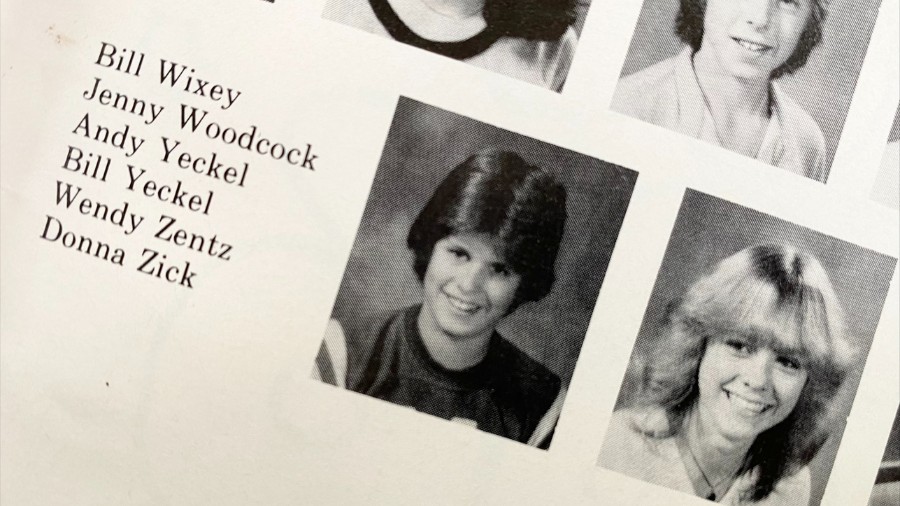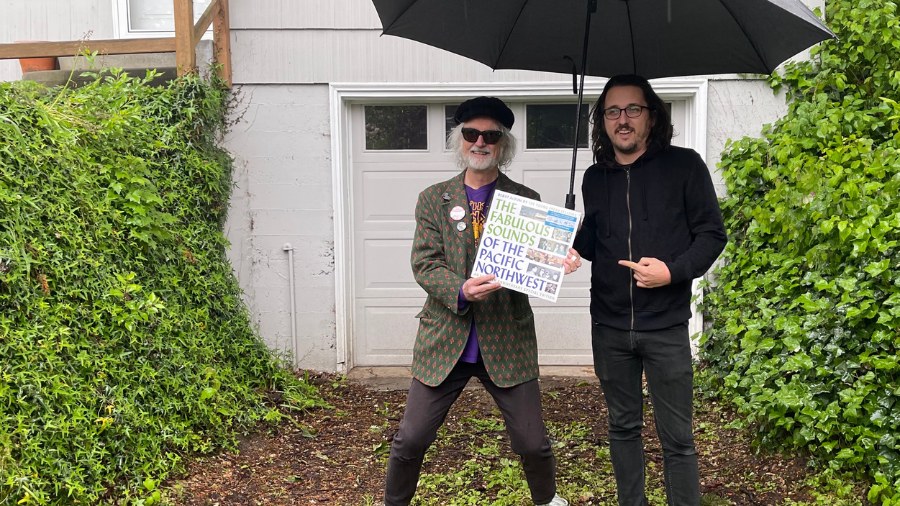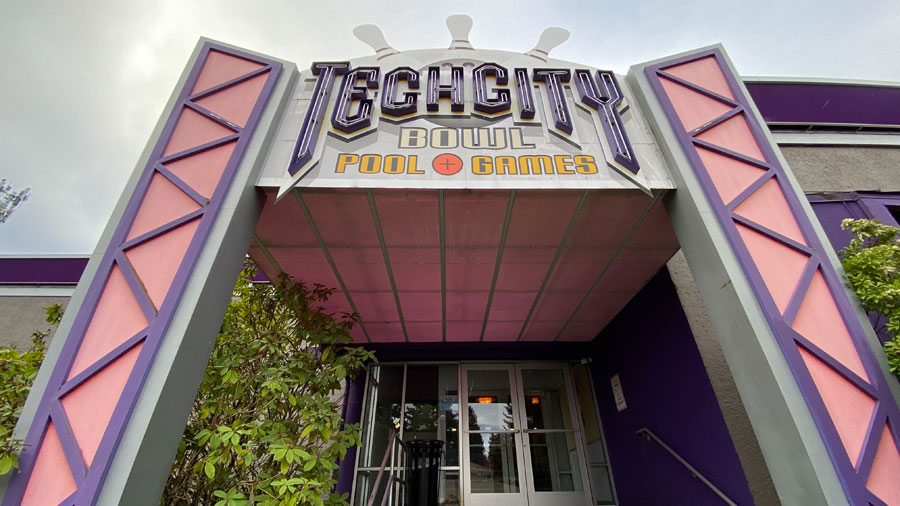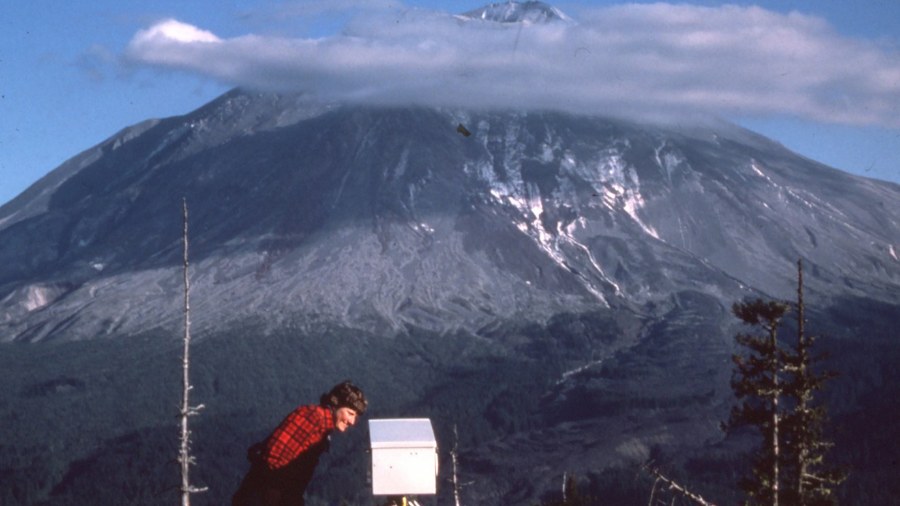Feliks Banel: Fifty years of ‘Wheedle on the Needle’
Feb 14, 2024, 10:34 AM | Updated: 2:10 pm

The book "Wheedle on the Needle" by Stephen Cosgrove debuted in February 1974; the book has since sold 2.5 million copies. Cosgrove is pictured with a Wheedle costume at an event marking the book's debut. (Images courtesy Stephen Cosgrove)
(Images courtesy Stephen Cosgrove)
It was 50 years ago when one of Seattle’s most enduring literary characters – who also became the Sonics’ original big-head mascot – was born. On February 14, 1974, the book “Wheedle on the Needle” was published, and quickly became a Northwest favorite that’s still in print.
For those not familiar with the book, the story of the Wheedle is essentially a kind of hyperlocal mythology – a children’s fairytale, really – to explain why there’s a red light blinking on top of the iconic Space Needle. Sure, that red light could also be thought of as a safety beacon to warn away approaching aircraft, but where’s the magic in that?
The five-decade-old Wheedle is the brainchild of author, publisher, and former Seattleite Stephen Cosgrove.
Cosgrove is in his late seventies now and lives most of the year in Colorado and Florida. A half-century ago, he was running a heavy equipment leasing company in West Seattle, but he had aspirations to become a professional writer. Cosgrove told KIRO Newsradio that the idea for the Wheedle came to him in November 1973 when he was doing some creative work with an ad agency. The client was the Space Needle.
At the end of a Friday afternoon meeting with the Space Needle team, Cosgrove told everyone within earshot that he had just written a book about the Space Needle.
More Feliks: Ryan House in Sumner named “Most Endangered”
“I said, ‘Uh, by the way, I just wrote a book about the Space Needle,’” Cosgrove said. “Which is just something I do, so it’s just a spontaneous stupidity on my part,” he explained.
The woman running the meeting asked what the book was called. Cosgrove says he made up the title on the spot – the Seuss-like “Wheedle on the Needle” – because the words rhyme.
Cosgrove also hadn’t actually written the book yet.
So, when the woman at that meeting back in 1973 then asked what “Wheedle on the Needle” was about, Cosgrove had to make up that part, too.
“I was sitting there, there was a magazine near to me and I looked down,” Cosgrove continued, describing the conference room where that long-ago meeting was held. “And it was a magazine featuring an article about Sasquatch.”
“And I said, ‘Oh, it’s about a Sasquatch-like creature that lives on top of the Space Needle.’” Cosgrove said. “And this was on a Friday, and she said, ‘Well, I’d love to see it. Can you bring it in?’ I said, ‘Sure.’ She said, ‘Can you bring it in on Monday?’ And I went, ‘Oh, sure.’”
“So I went home that night,” Cosgrove continued. “And I wrote the story ‘Wheedle on the Needle’ just about exactly as it is now.”
He also got help that Sunday with an illustration of the “Wheedle” from a young artist named Robin James, daughter of Bob James, the art director who designed the Bon Marché Christmas star back in the 1950s.
When Monday came and Cosgrove shared the story and illustration of the Wheedle, the Space Needle folks loved it so much that they immediately placed a huge order for hundreds of copies of the book that didn’t yet exist. This ultimately meant that Stephen Cosgrove had to become a publisher very quickly. He quit his day job a few months later.
As anyone who was a parent or a child in the Northwest from the 1970s on likely knows, the Wheedle is a big orange and fluffy creature who had lived in the Puget Sound area for thousands of years undisturbed (insider tip: in the original illustration, he was green).
In Cosgrove’s telling – as dashed out that long-ago Friday night in November 1973 – the rise of the modern city of Seattle made the Wheedle mad, and the sound of all the happy people whistling hurt his ears. So, the Wheedle grabbed a bunch of clouds and climbed to the top of the Space Needle to make it rain so the people of Seattle would be sad and would stop whistling. Of course, there’s much more to the story, but it all ends on a happy note.
More NW History: Remembering how Boeing helped bring The Beatles to America for their first-ever visit
“Finally, the mayor comes to him and says, ‘What can we do?’” Cosgrove told KIRO Newsradio, describing the ending of the story. “And [the Wheedle] explains, and so they build him a great big pair of ear muffs to block the sound, and he goes back to sleep on top of the Space Needle.”
“And as he sleeps every night, his red nose blinks,” Cosgrove said.
“Wheedle on the Needle,” along with many other local titles published by the company Cosgrove created – Serendipity, named after another popular title written by Cosgrove – was a colossal success. Thanks to Cosgrove’s dogged work and the appeal of the stories, the low-cost paperback books were available to purchase pretty much everywhere, including grocery stores, in the 1970s and 1980s for just 99 cents each. Cosgrove estimates that “Wheedle” alone has sold about 2.5 million copies.
Along the way, the Wheedle character also became ubiquitous for a while – first as a sort of unofficial mascot for the Seattle Sounders during their early years at Memorial Stadium since Cosgrove’s office was nearby on Lower Queen Anne Hill.
Irene James, illustrator Robin James’s mom, built the first Wheedle costume, and Cosgrove himself was often the guy wearing the suit along the sidelines. Then, when the Sounders moved after two seasons from Memorial Stadium to the new Kingdome, Stephen Cosgrove went to the nearby offices of the Supersonics and asked Coach Bill Russell if the Wheedle could become the Sonics’ mascot.
Coach Russell was skeptical, Cosgrove said, but open-minded.
“He said, ‘We’re going to give him a try,’” Cosgrove explained. Then, according to Cosgrove, Russell said, “’I’ll tell you what, you come once. If they like it, we’ll do it. If they don’t, I don’t want you back here again.’”
“I said, ‘That’s okay because if you don’t want us, I’ll just buy a ticket, and I’ll sit up in the audience in the costume,’” Cosgrove said, which made Coach Russell laugh.
“He roared. He thought that was funny,” Cosgrove explained. “So we did the one game, and people went nuts, and so the Wheedle became the mascot for the Sonics.”
The timing was right, with the Sonics on the verge of their near-miss of the NBA championship in 1978 and their one and only championship season of 1979. The Wheedle was handed a pink slip sometime after the Ackerley family purchased the team in the 1980s.
Of course, the Sonics are long gone, but hope springs eternal that an NBA franchise will return to the city. That team is going to need a mascot, of course.
Whatever might happen in the future with the NBA, 2024 is the Wheedle’s 50th anniversary, and Stephen Cosgrove is also hoping for a resurgence in interest in his creation, which surely must rank high if there ever were to be a list of well-known Pacific Northwest literary characters. After all, if New England has Hester Prynne, New York has Holden Caulfield, and Atlanta has Scarlett O’Hara, why can’t Seattle’s greatest literary character be an orange Sasquatch-like creature who lives on top of the Space Needle?
Cosgrove will launch a new Wheedle book in April at an event sponsored by the Space Needle, and he’ll also be taking part in the Seattle World’s Vintage Fair, an event held at Seattle Center in August.
You can hear Feliks every Wednesday and Friday morning on Seattle’s Morning News with Dave Ross and Colleen O’Brien, read more from him here, and subscribe to The Resident Historian Podcast here. If you have a story idea or a question about Northwest history, please email Feliks here.













